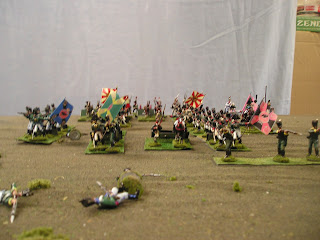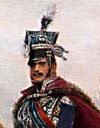I have been experimenting with solo play rules and concepts since the isolation of the pandemic lockdowns began.
I have a few books about the subject of solo play from Grant and Featherstone, yet none of them have a simple yet easy to use system.
So here I am proposing my own, one that I have played out on the tabletop in ECW and Napoleonic games - and sampled using Squad Leader (WWII).
 |
| set of tools |
In essence any solo system has to bypass the 'know it all' that the player operating it has.
This makes any real 'surprise' events difficult, so that is best to not expect from almost any solo play system.
Alright so that is out of the way here we go:
First, have some chips, or blocks, or beads that are different color, yet not different shape or texture, so that you can have them in a bag or cup.
I have used 2 for each 'command' and 3 for the overall commander and 3 extra as a start mix.
This means for a sample SHAKO game, with two foot and one horse division, you get 2+2+2+3+3=12 'markers' or 'chips' or 'beans'. I used Orange ones for the Parliament and Purple ones for the Royalists in an ECW game.
 |
| 'markers' or 'chips' or 'beans' |
With this mix for each side I then add two 'other' color ones and one RED or TURN END marker.
These beans are going to be used to determine if or whether orders can be changed. So if you want more order change possibility, then reduce the number of beans, or add in more of the RED ones; keep reading you will understand.
Each command then gets a card from the deck - you may do total random, or not as you please.
 |
| tools |
Tools meanings:
Spades = attack to kill or cause maximum death (even if that means your own death)
Clubs = operations (attack or defense) in a planned way - using maximum combined arms
Diamonds = operations (attack or defense) using maximum expenses, ammunition, fuel or technology
Hearts = defensive mindset with preservation of your own forces as the primary consideration
the numbers on the cards can be included as 'how much effort' or 'relative energy' they will put into the operations, where a 2 is 'meh I'll follow it sort of' and 10 is 'this is the way...'
the face cards then become certain personalities (or simply 11, 12, & 13)
Jack: the opposing division or sub formation commander is the 'target' of operations.
Queen: the opposing 2IC (if possible) or 2nd most important (valuable) asset of opposition as overall target.
King: opposing command is target of operations (if not possible then most important (valuable) asset)
Aces are the 'purest' form of the tactical technique, so ace of spades will be to 'kill, kill, kill' (even your own men!) and ace of hearts will be to prepare for with drawl or move to a perfect defense taking no life-and-limb risks at all.
 |
| useful tools |
 |
| no card deck? print this |
After drawing the cards (or assigning them), for the commands and setting your plan (or preparing for attack with spades!). Set your table/troops according to plans and rules for the game you are using.
Draw three 'beans' before the game start - this sets 'initiative' unless there's a scenario demand for it.
Draw three 'beans' each side at the start of each turn (before normal rules) - this will then set-up your orders options.
So at the start of turn 1 there will be 6 beans for each side drawn. These get compared, for example, if there's a majority of the side drawn: ie I am Parliament and I draw3 orange 2 purple and a green, then the orange is dominant and the Parliament may make 1 order change. If all 6 are orange, then they may make 6 order changes. For each order change one 'bean' is put back in the bag.
If the totals are equal or favor the opponent color, (orange and purple) then NO ORDERS may be given. Alternately you could allow a 'tie' to permit one order - provided both sides want/need one order.
Any time a RED or turn end 'bean' is drawn (in the three) then, at the end of the turn, the whole group is 're-set'.
A re-set consists of 1/2 (rounding to be explained) of ALL 'BEANS' to be put back into the draw bag.
this is where the two green (or other color) and RED (turn end) 'beans' become important.
1/2 eliminated is easy when the number is even and there's no 'other color' 'beans' in the mix
If the number is odd and no 'other colors' are involved then the side who is in control of that set of 'beans' gets to decide which 'extra' 'bean' is discarded back into the draw bag.
If there are 'other color' beans available (including the RED (turn end) 'bean') then the player who drew them may decide which 'color' (purple or orange in the example) those green or RED 'beans' will be used as in discard.
Example:
Parliament player drew the RED 'bean' and has a green 'bean' also 7 Orange and 8 Purple 'beans' -thus has not been able to give orders.
The Royalist player has 6 Orange and 6 Purple - also not able to give orders.
at the end of the current turn, BOTH PLAYERS will discard 1/2 of their 'beans'
Royalist is easy, 3 of each.
Parliament must discard at least 3 Orange and 4 Purple 'beans', yet may substitute 2 of them as the green and RED ones that they have. This means at the end of the discard the Parliament side could have 5 Orange and 4 Purple 'beans'; having discarded 1 Orange 1 green and 1 RED (as the 3 Orange ones required) and the 4 Purple 'beans'.
This 'turn end' discard action is what creates the imbalances at times, along with the two 'other' 'beans' along with the draw of 3 at a time. The idea is to create an unknown ability to change orders, leaving the player to have to continue with orders 'as is' until the change comes about and the player in solo-play mode will not have knowledge of exactly when that will happen from turn to turn until the very start of the turn (or at least BEFORE clearly being able to do the orders change).
 |
| anything can be used as 'beans' |
The intent here is to take advantage of the axiom "no plan survives contact with the enemy".
 |
| the colored blocks come in many colors |
Tell me what you think gentlemen.

















































































































